How to One Arm Handstand
There is something magical about one arm handstands. Something mystical even. Even after all these years I find fascination in a body standing upside down supported by only 1 hand in the middle of an open space.
If you can not do a one arm handstand yet the move is impressive as it is just so very unimaginable how to do it. If you are on your journey towards the OAHS your appreciation and admiration will grow with every training session. The more you know about the one armed handstand the more you understand how much time and work goes into perfecting it.
Is it possible to do a one arm handstand?
Yes, with lots of training, focus on the correct technical details and patience you will absolutely learn to One Arm Handstand.
This is a question that I honestly receive more often than you would expect and while it might seem silly considering I can stand on 1 hand for very long periods of times I do understand the question. The stigma about OAHS has changed drastically over the past 20 years.
When I grew up and first got into hand balancing there was only a handful of people who were able to stand on one hand. Take anybody from East Europe or China out of the equation and you end up with close to none.
There was an intense lack of resources and education on how to do a one arm handstand. When I said I at age 14 that I was going to become a professional Hand Balancer I was laughed out of the room.
It was believed that the only way to learn a one arm handstand is to start at age 5 and to receive secret tips from famous coaches. Fast forward 20 years, along came YouTube and ambitious coaches and performers like myself and you can find someone able to do a one arm handstand in every state almost even every city.
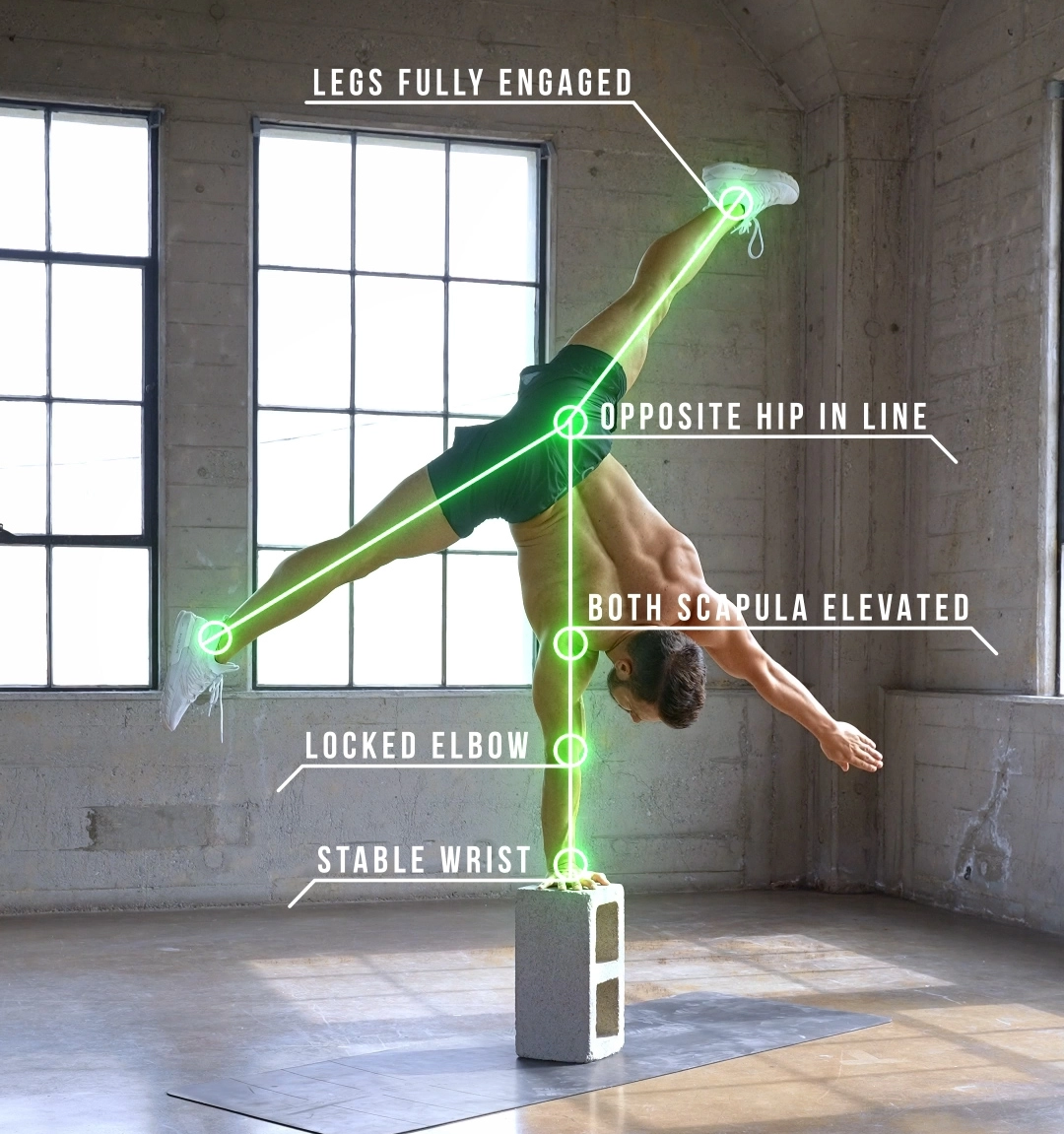
OAHS Prerequisites
Let’s do the boring stuff first. There are 2 separate reasons for why someone might be training OAHS. The first is to improve their handstands in general, to get stronger and to gain more control for their two arm handstand. The second is that someone is actually training One Armed handstands to lean the one armed handstand.
One Arm Handstand drills are great for pretty much anybody who wants to improve their handstands but in order for these drills to actually help you improve your oahs your regular handstand needs to be beyond stable. You should be able to switch between common positions and to do single leg isolations in all directions without losing control or even bending your elbows.
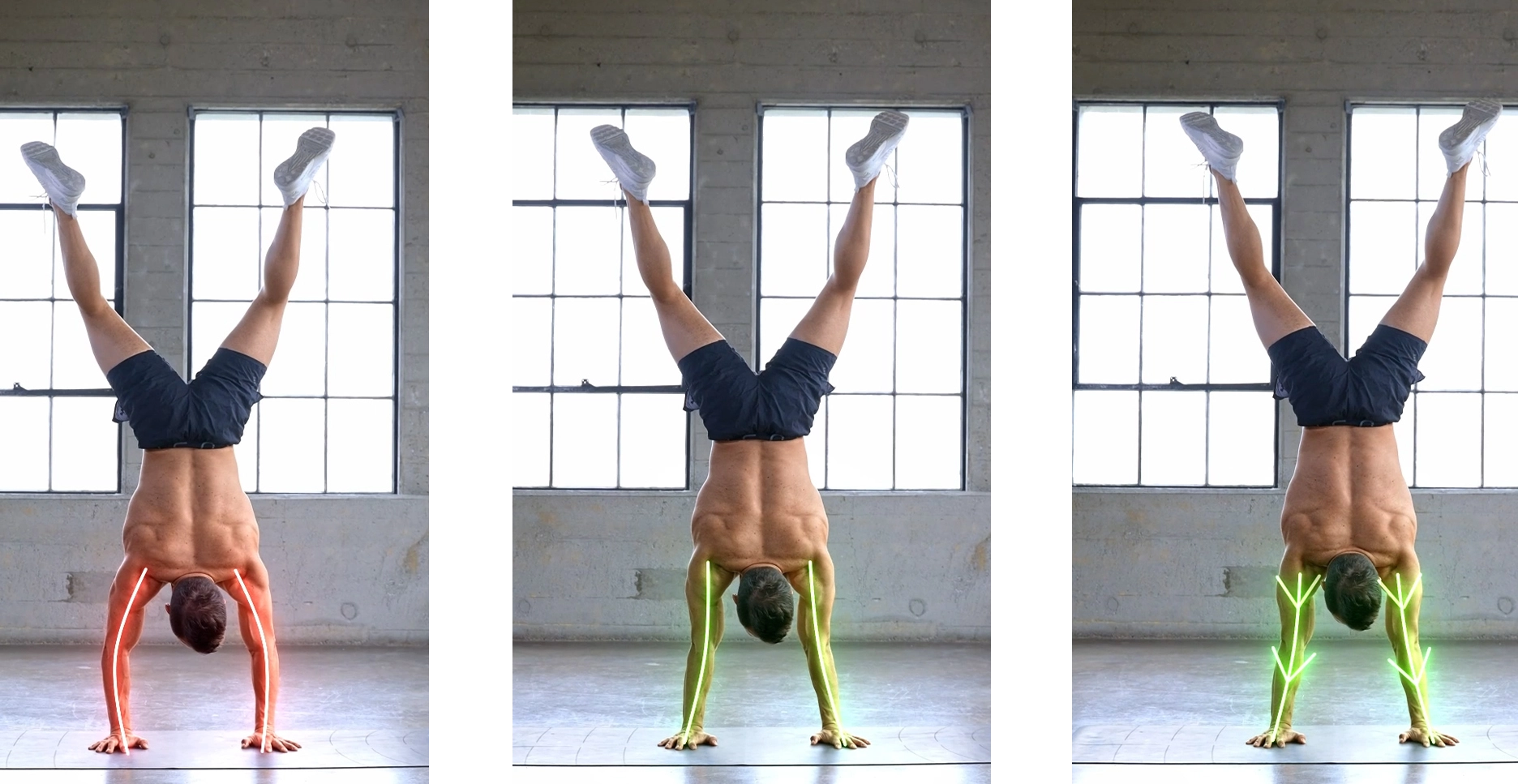
Whilst handstand push ups, presses and planches are not necessary at all it is helpful and suggested to bring extra strength to the table for reserves and easier control. A general level of fitness is required for your body to be able to recover on time for the next workout. Handstand training for such advanced skills is hard and needs to be performed quite frequently. If you are not in shape your body won’t be able to cope.
If your regular handstands are not great yet use oahs drills as tools to build additional strength and coordination but do not expect to nail your OAHS any time too soon. Before you can run you have to learn to crawl and to walk!
[ays_poll cat_id=10]
How do you do a one arm handstand?
One of the main things that has changed in the approach to one arm handstands over the past 20 years is the clear technical understanding. OAHS do not just happen by coincidence. There is a precise reason on why and how OAHS should work. Some might argue that technique depends on body type and person. This is only very partly true.
There is a correct technique that everybody should strive for. Make adjustments due to personal limitations but start by shooting for the moon! The one armed handstand is a very advanced move that requires a high level of athleticism. You have to treat it as such!
1. Control. Do not balance
This is one of the most important things to understand early on. You are not using balance when standing on one hand. You are controlling everything. Spread your fingers wide and create a strong connection with the floor. Take control of your handstand! Movements of your hand are significantly more precise than anything you can do with your foot. Yet when standing on 1 foot you would not consider yourself as using balance.
You are balancing when walking on a railing as you need your spread out air plane wing arms for balance. When standing on 1 foot or one hand you are using your ankle or wrist to maneuver your position. Change your mindset. Handstands are never balanced. Take control of your body!
2. Look at your hand
Personally, I look at the knuckle of my pointy finger and I recommend doing the same. I’ve spoken to countless professional hand balancers about where to look. Whilst pretty much everyone looks at a different spot we all agree that looking somewhere on your hand is the superior choice.
By looking at your knuckle compared to for example the floor provides the advantage that you are independent from outside influences. It does not matter if you are training on the floor, bars or canes the distance between your eyes and the focus point stays consistent.
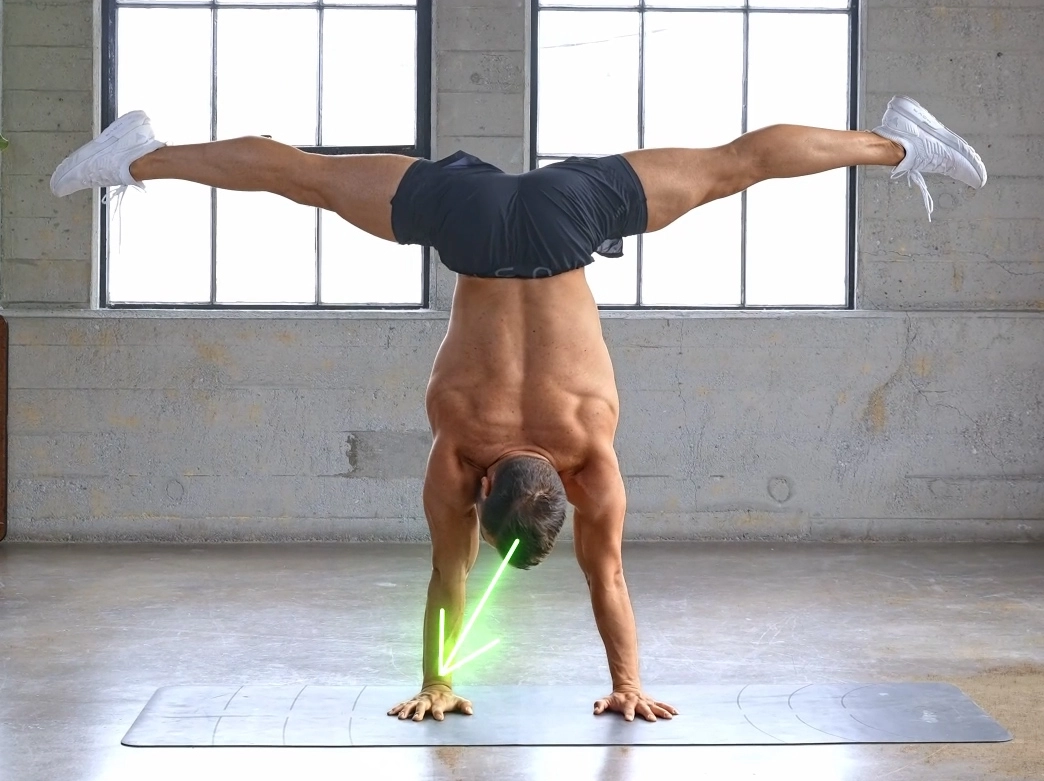
3. Align your supporting shoulder and push out tall
Once looked at your hand the next step is to bring the supporting shoulder on top of your hand. You want to be in a straight line right on top of the center of your hand. Keep in mind that when training for the regular 2 arm handstand the weight is in between your shoulders and you are using your chest and anterior deltoid muscles primarily.
Now for the first time you are transferring out placing more pressure on the outside muscles of your shoulder. Your posterior deltoids are not used to this and you have to prepare them accordingly.
Make sure to elevate your scapula fully. Yes, you had to push out tall on 2 hands. Now on 1 hand you have to push even taller.
4. Align your opposite Hip
Next up are the hips. Side bend gently. You have to bring your opposite hip on top of the supporting shoulder. The goal here is to isolate the side bend between the last rib and the hips exclusively. The more that you will be able to isolate this movement the cleaner and more controlled your one hand handstand will be.
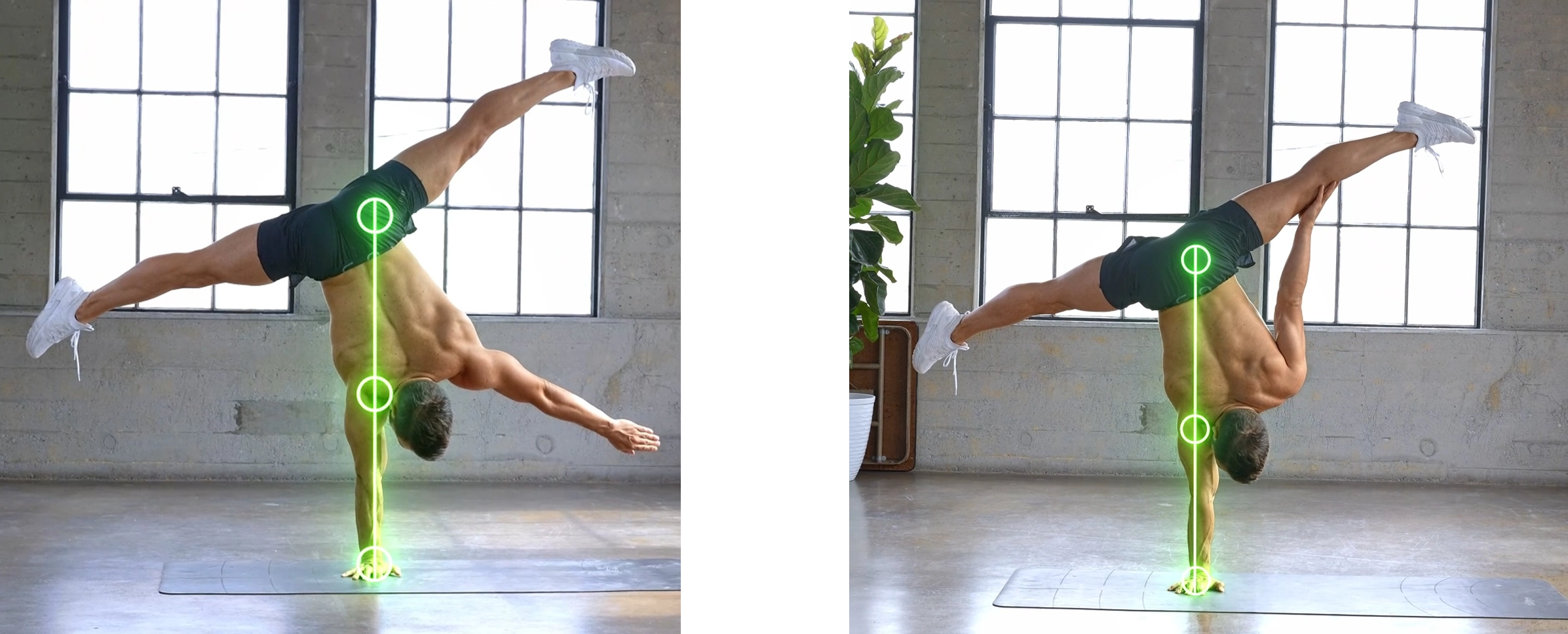
5. Don’t forget about your legs
When looking at the one arm handstand it is very easy to be so focused on the hand, shoulders, hips and trying to hit a straight line that we easily forget about the legs. Your lower body is heavy and makes up more than half of your entire body. If you don’t manage to control your legs you will fall.
Engage your legs fully. If you are practicing the straddle position truly open your legs in a full straddle. Lock them there. If you are working legs together keep them together. Press them together so hard that they become one single leg.
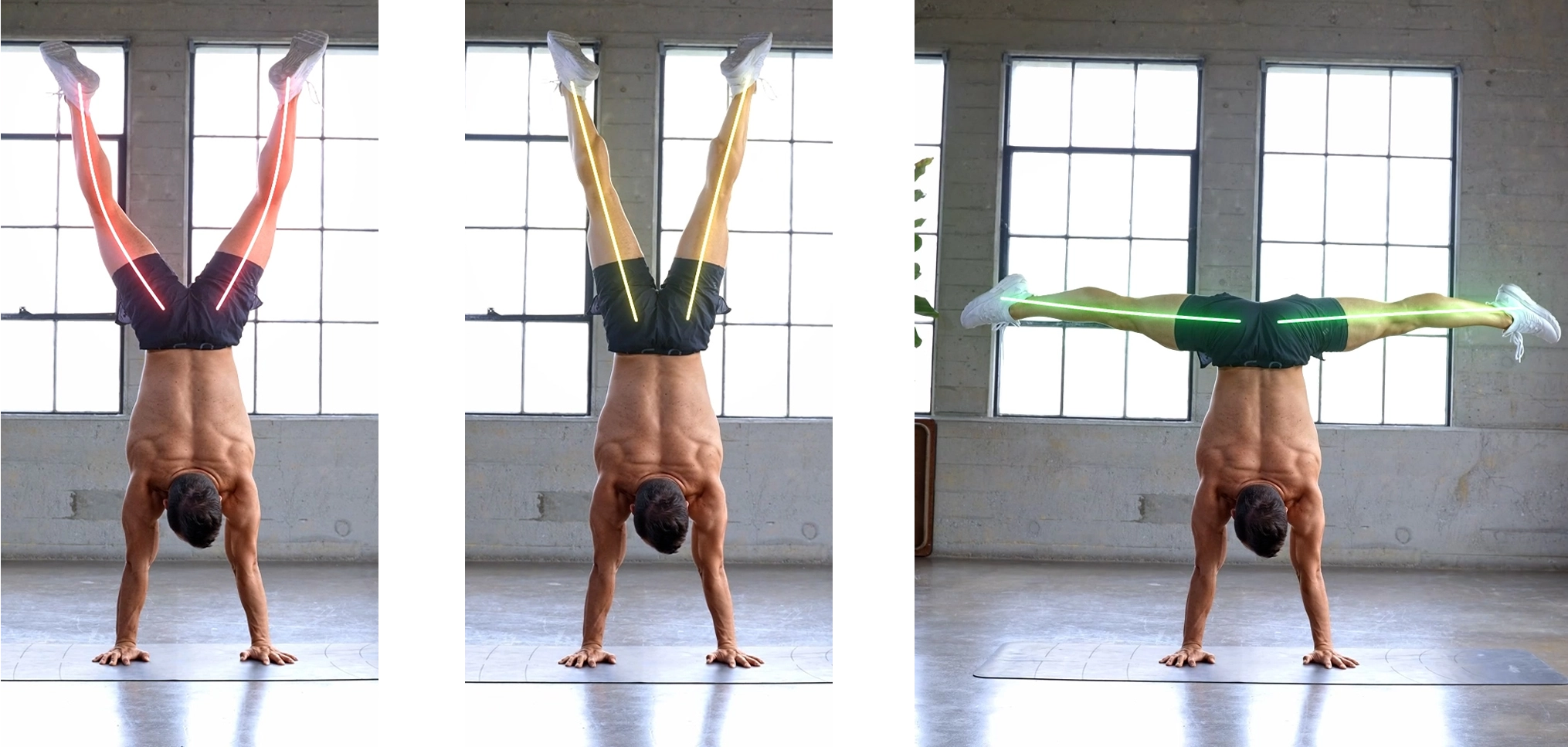
What are Common mistakes of the one armed handstand?
The problem with learning the one arm handstand is that balance, control and alignment is very 3 dimensional which means mistakes can and will happen in all directions. Minimizing the chances of said mistakes happening must be our #1 priority. In order to correct and eventually finally cut mistakes out we first need to understand them.
Filming yourself when training is key here. Almost everyone has a smartphone nowadays. Use it! It is one of your best tools! When filming yourself don’t just look at the video after your set. First get a clear imagine in your head of what you think you just did. Then compare this image with the video on your camera.
Lack of Scapular Elevation
One of the main issues of all failed inversions is a lack of shoulder push. If you don’t have it on 2 hands yet you can not expect it to work on one. Elevating the scapula fully will give you control, a straight line and protect you from injuries.
It is important to understand here that there is a difference between elevating the scapula and opening the shoulder. It is ok to keep a small angle in the shoulder as long as you push both shoulders all the way up to cover your ears.
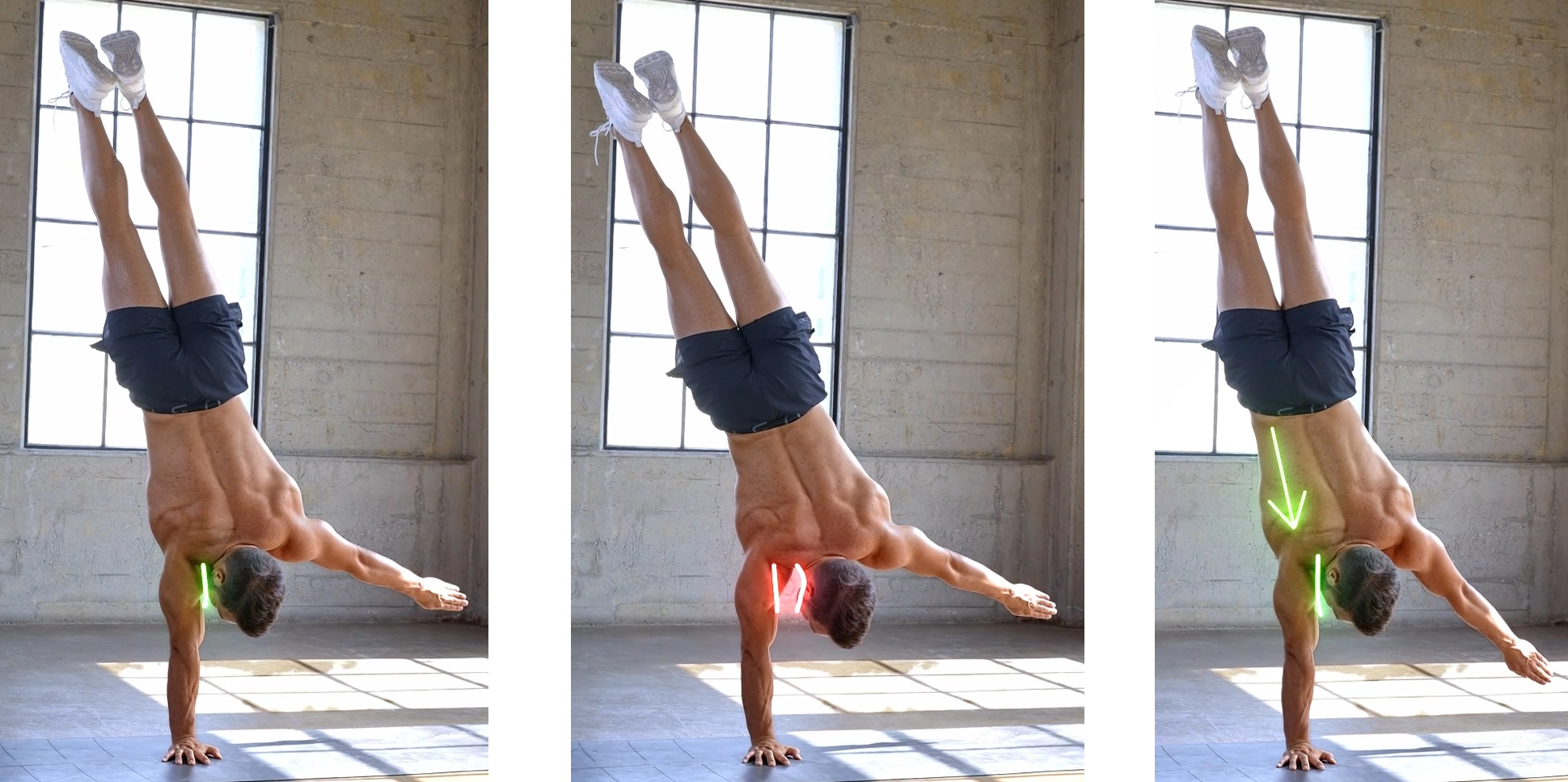
Free Shoulder Moves
Probably the most overlooked detail of the OAHS is the free shoulder. It has to stay down close to your ear or even chin. If you pull the free shoulder up and away from the floor your lat engages. This one pulls your hips back to parallel and you fall back towards your second hand.
Additionally, when ever we pull the shoulder up we also pull it towards the back. This is making you rotate. Your body always follows your free shoulder. Keep it low and isolate if you don’t want to fall.
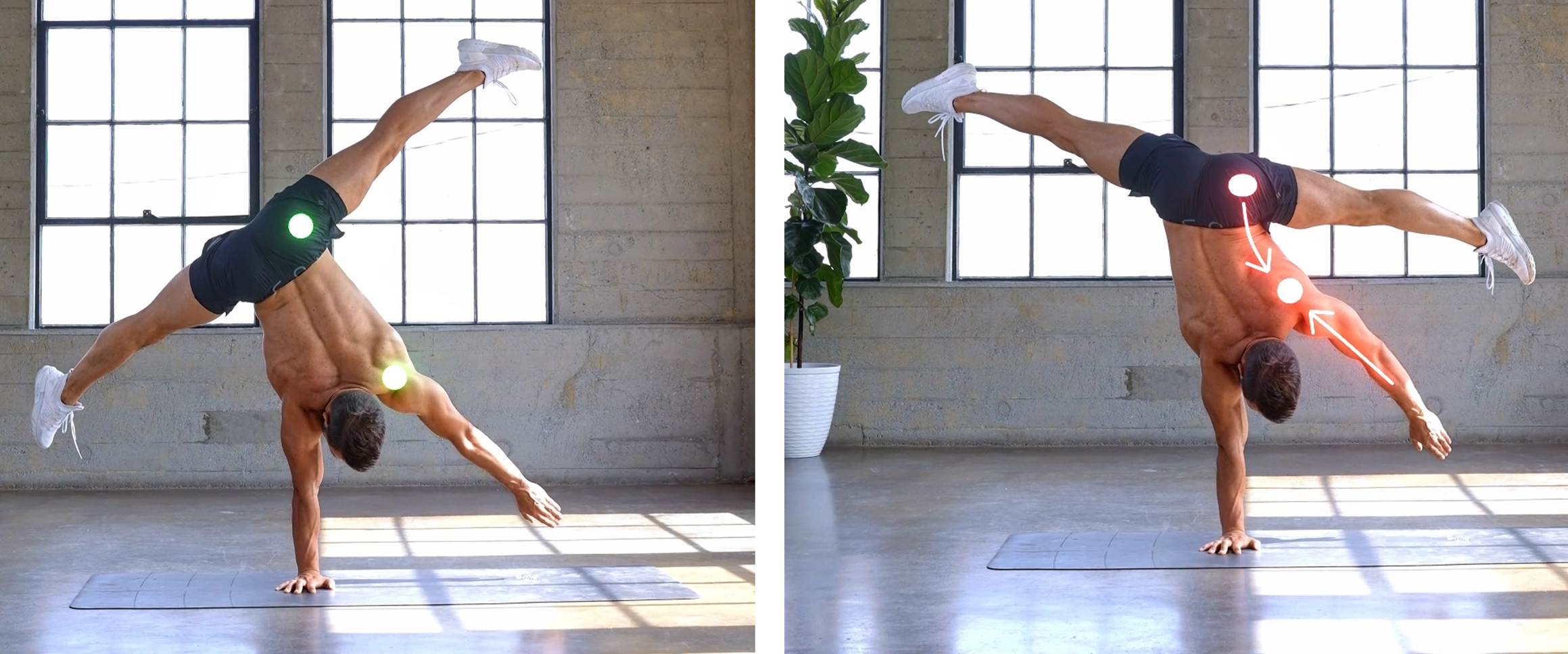
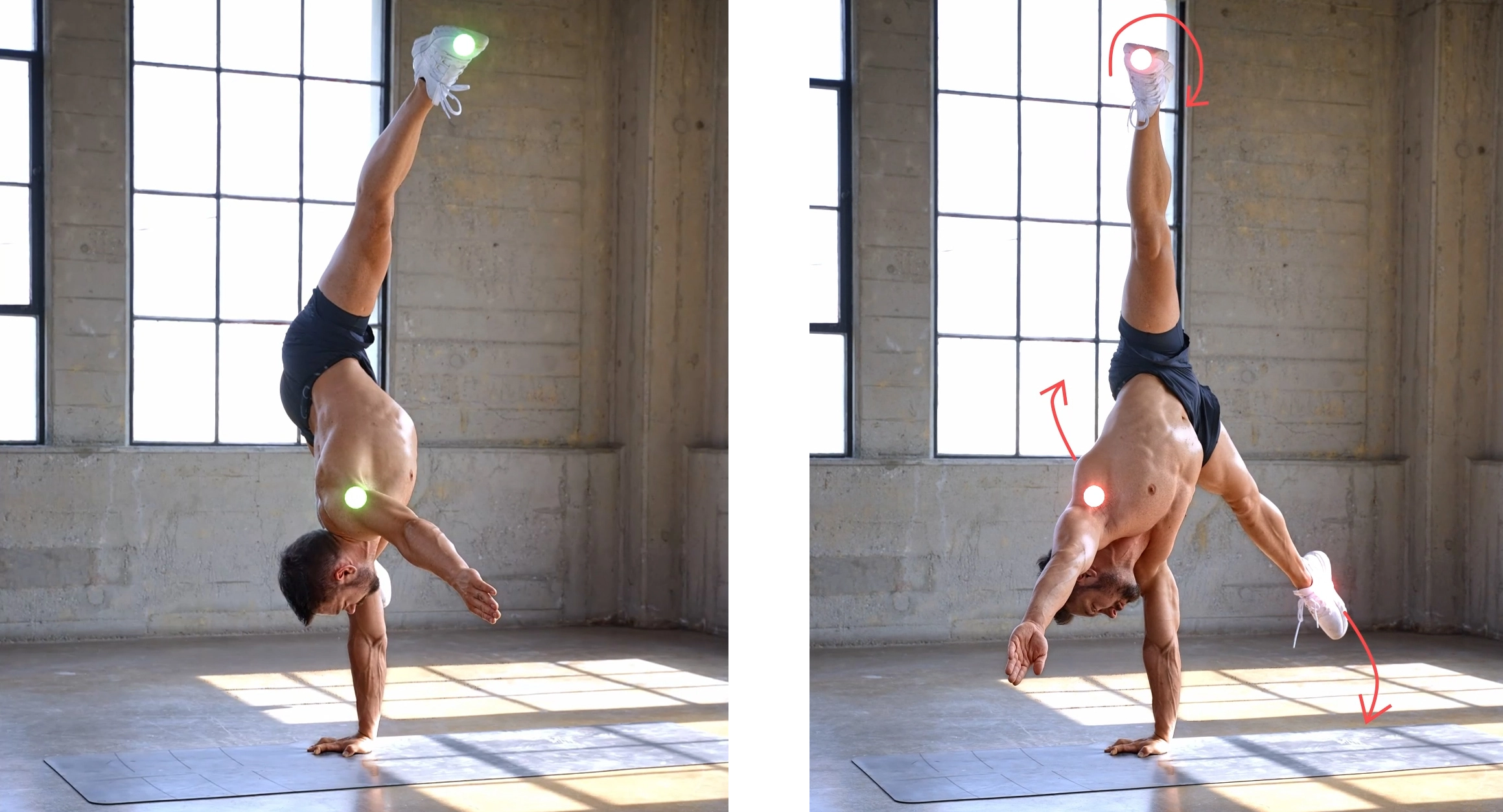
Supporting shoulder not over hand
Not quite as common but still an issue that I see pretty often is the supporting shoulder not being on top of your supporting hand. This is usually either due to a lack of coordination or simply because you do not trust your shoulder enough.
Athletes usually understand that they have to bring the weight out towards the supporting hand. If the supporting shoulder does not make it all the way on top of the floor hand the athlete will often side bend significantly more than they should to be able to release the opposite hand.
Not only is this position rather difficult to balance but also does it put your shoulder in an inconvenient position making it fragile for injuries.

What are the best one arm handstand Progressions?
A bit problem of people trying to achieve to stand on one hand through handstand training is a lack of exercises and progressions. People often rock up to training and then simply try to stand on one hand. Just like with everything: in order to learn new skills, their technique and to exercise the right muscles we need to work on specify skills.
2on2 or Narrow Handstand
One of the first things you have to practice is the narrow grip handstand. As mentioned before you need it in order to prepare your outside shoulder muscles, your posterior deltoids to withstand the pressure of the one arm handstand.
Narrow grip handstand training will also help you keeping the free shoulder down during your one arm handstand. In the narrow grip handstand both shoulders are pushing up and even inwards. This is the closest that you will get to a one arm handstand on 2 hands.
Deep Side Bends
An absolute essential to practice when working towards the one armed handstand are side bends. Whilst generally the deeper side bend the better you don’t have to be a side bending contortionist to do a one arm handstand.
Much more important is that you can side bend without rotating the legs. Keep your shoulders fully elevated and both elbows locked. The side bend should happen between the last rib and the hip bones.
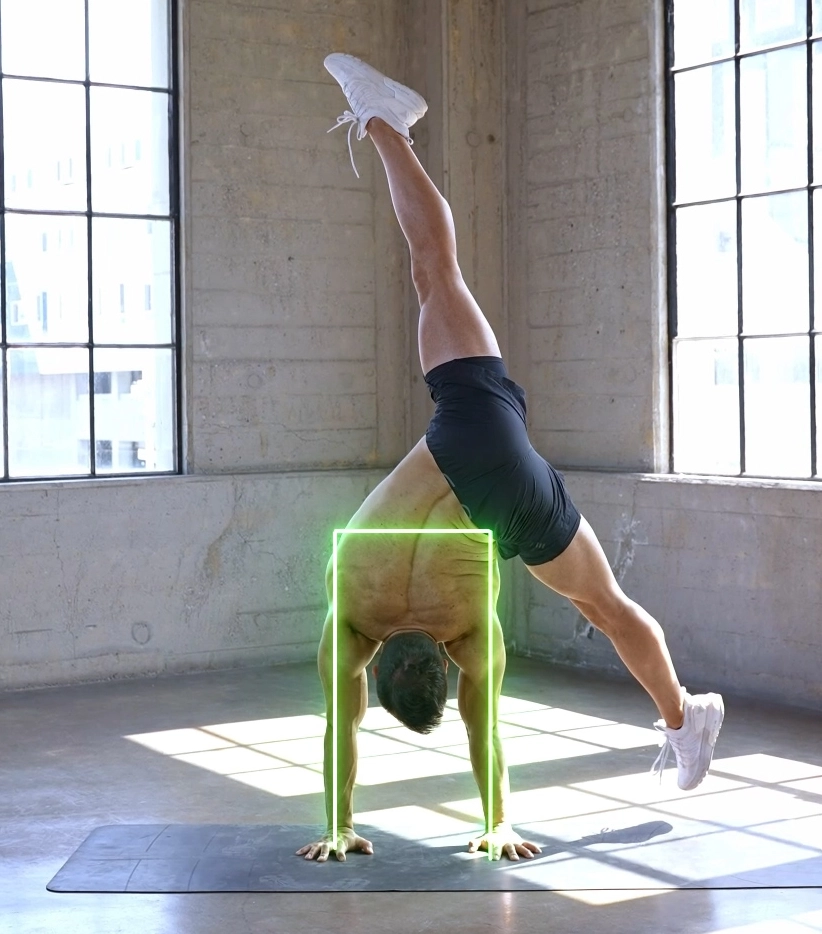
Miami Handstand
A Miami handstand is an inversion balance where 1 hand is elevated on a handstand block, a yoga block or a pile of books. The Miami Handstand represents a milestone on your journey towards the one hand handstand. Pretty much every single advanced one arm drill comes through this position so get good and stable at it.
The goal here is to have equal weight between both hands, shoulders and hips parallel to the floor and for the shoulders to be fully elevated. In order to do this you will have to bend the block elbows slightly to make up for the height of the block.

What are the worst one arm handstand progressions?
Many roads lead to Rome and honestly, if you work very hard and stay very consistent you can learn a one arm handstand with most approaches. Yet, there are certain exercises that will encourage bad habits or give you the feeling of “fake” progress. If a coach recommends you to do these exercises and doesn’t have a very strong explanation or reasoning to why you are supposed to do these progressions it might be a good idea to leave…
Piano Fingertip Holds
The most common and simply worst beginner one arm handstand drill. The idea is simple. Do a handstand on 2 hands. Then go up on your fingertips. Eventually you will only have 1 finger on the floor before doing it without any help. This approach might work for strength moves but makes no sense for one arms.
The problem is that pretty much any beginner will pull up their shoulder on the way to the fingertip position which will then result in rotation when finally taking the hand off. Additionally it is fake progress. You are not actually getting better at the core technique of the one arm handstand. Instead you are simply getting stronger fingers.
Wall Assisted One Arm Handstands
Also a cute idea but not very useful. If you need the wall to balance you are not ready to practice one arms yet. Focus on improving control and balance first before circling back around to the advanced exercises. One arms are very 3 dimensional where the weight always has to be in the fingertips. Yet as you are leaning against the wall you can not get properly aligned on top of the hand.
The only time to use the wall for one arm handstand training is when you are working on side bend coordination or conditioning drills.
How to train for the one arm handstand?
The more I travel and teach handstands the more I realize that only a handful of people actually understand the seriousness of one arm handstand training. I encounter lots of athletes who are trying to practice with as many coaches as possible simply to find that magic solution, the tip that will fix their handstand. Sorry to disappoint but there is simply no magic potion.
You are going to have to work hard and for a very long time. My goal as your coach is to make this road efficient by providing you with the best drills there are and to keep the journey fun and exciting but minimizing risk for plateaus through countless baby steps and progressions.
How often should I train for the one armed handstand?
Honestly, as long as your body is able to recover fast enough more is better when it comes to OAHS. The main limiting point usually is not strength but coordination. In order to build enough body awareness to balance upside down on one hand you have to spend lots of time doing so. When you take a day off you do not pick up where you left off but you actually take one step back.
If possible I recommend training for the OAHS 6 times per week but I have seen plenty of clients achieve their goals with only 4 highly focused workouts per week.
How long should my training be?
Here longer is not necessarily better. OAHS training is taxing on your general nervous system. It is hard work and besides the regular physical fatigue you will get tired mentally. I can guarantee that.
Keep you workouts around 90 min.
What should my training session consist of?
A proper one arm handstand workout is quite complex and should cover all the essential to not just get better at OAHS but also to keep your body healthy, improve the basics and get stronger in specific handstand strength.
Start with a general warm up to break a light sweat followed by prehab exercises for your shoulders, back and wrists. If you have to time add stretches at this point for your middle split. The better the middle split the easier the OAHS. Follow this by your basic 2 arm skills training. Rotate them to get a wide variety of 2 arm progressions throughout your week. Only after those is it finally time to work on your oahs before finishing the workout with specific strength drills. Depending on your workout split I would rotate Scapula elevation strength and HSPU with presses and planches.
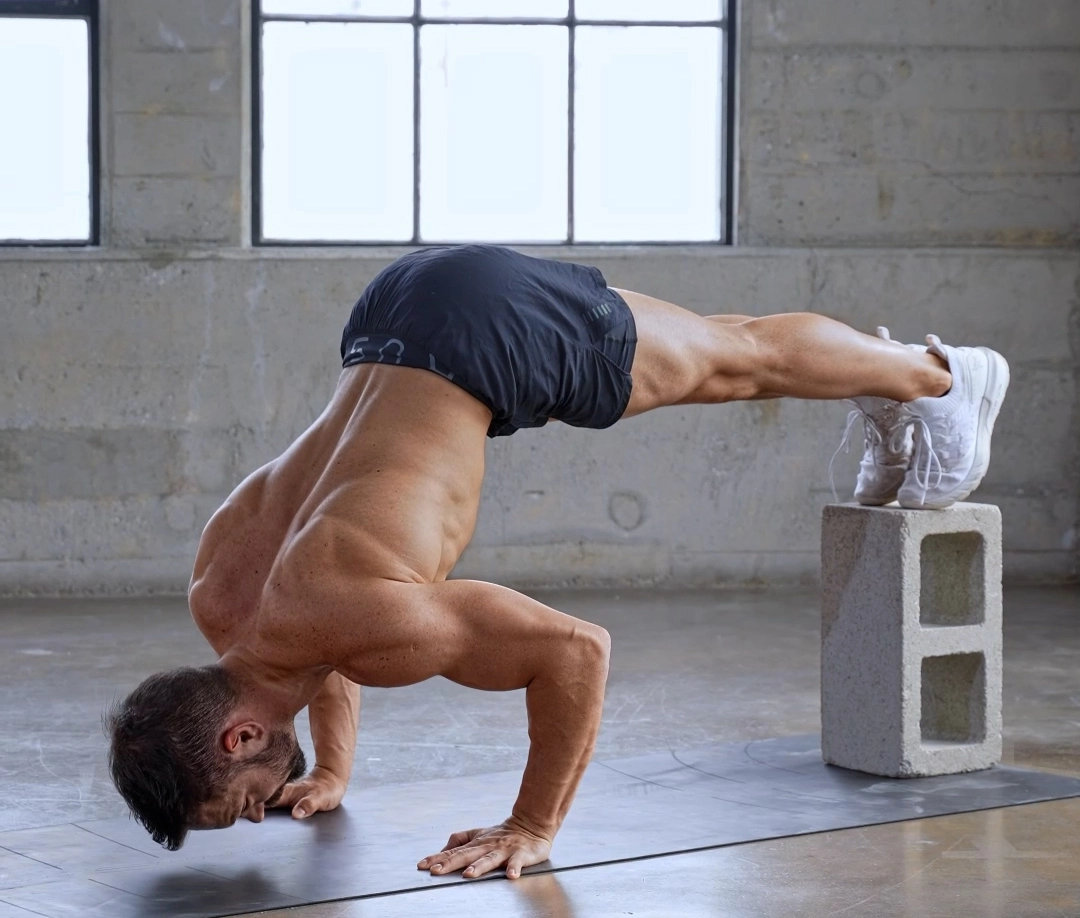
Floor, handstand blocks or handstand canes?
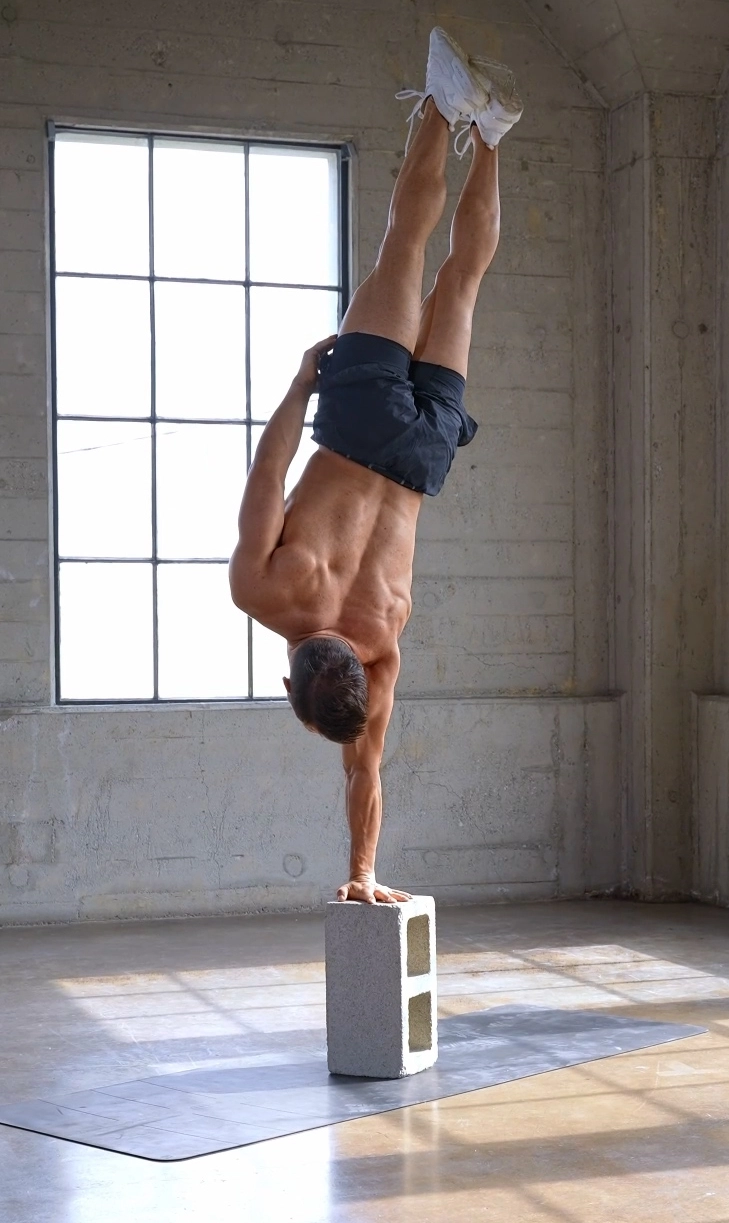
No matter what you practice on your body will need about a week to adjust. At first anything new will feel wrong. Once used to the equipment handstand canes are significantly easier to balance on than on blocks and the floor is by far the hardest.
Blocks are easier than the floor as you can use the edge of the block to pull yourself back towards the front in case your weight drops into the back of the hand. This might seem like a bizarre idea but it really works.
Canes are again easier to due to the light shake. If you start to fall out in 1 direction the canes moves with you and basically pushes you back. This of course only works when used to the movement of the canes. Additionally, canes allow you to take your free hand off and place it lower than the block. This makes balancing easier as you won’t be as tempted to pull the free shoulder up.
Assuming that your blocks are not too wide they are significantly healthier for your wrist. On the floor the hand is constantly stretched out which can lead to long term overuse problems.
Handstand blocks are absolutely essential when training for the OAHS. Almost all known progressions use blocks. You will be able to work on coordination, strength and balance through countless progressions.
Train on blocks yet understand that your first one arm handstand holds will be on canes.
Common injuries when training for the one arm handstand
If you train smart, listen to your body watch your form and recovery times you should not encounter any injuries on your way to the one armed handstand.
While we hope for the best we have to prepare for the worst. Most typical one arm injuries occur due to overuse and/or lack of proper warm up. Just because it is warm out and you sweat from walking in the sun to your training spot doesn’t mean your wrist is warmed up and ready to support your weight.
One arm handstand pains are usually exclusively happening in the shoulders or wrists. Ice your sore spots after training for 8-12 min and a second additional time right before bed. If pain does not get better after 2 days reduce training volume heavily. If you don’t feel better after a week you have to go see a doctor.
How long does it take to do a one arm handstand?
The road to the one arm handstand is long and extremely individual. It is impossible to say how long it will take for you. Deciding factors are your current level of handstands, time on hand to practice, your ability to motivate yourself on a long term picture, how fast your body is able to recover and on your current fitness level.
Let’s assume your 2 arm handstand is fairly stable and you can change between shapes without bending your elbows. If you practice 4 times per week for 90 min 2 years is a realistic window to get your one arm handstand. I’ve had clients who got there in as little as 6 months but also seen cases where it took much longer.
The journey is the destination really is the motto here. When training for the one arm handstand there are no short cuts. Often it is even better to take a longer road and to practice a progression for a little while longer in order to improve form and awareness
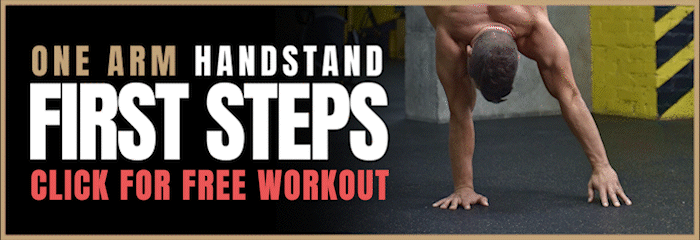
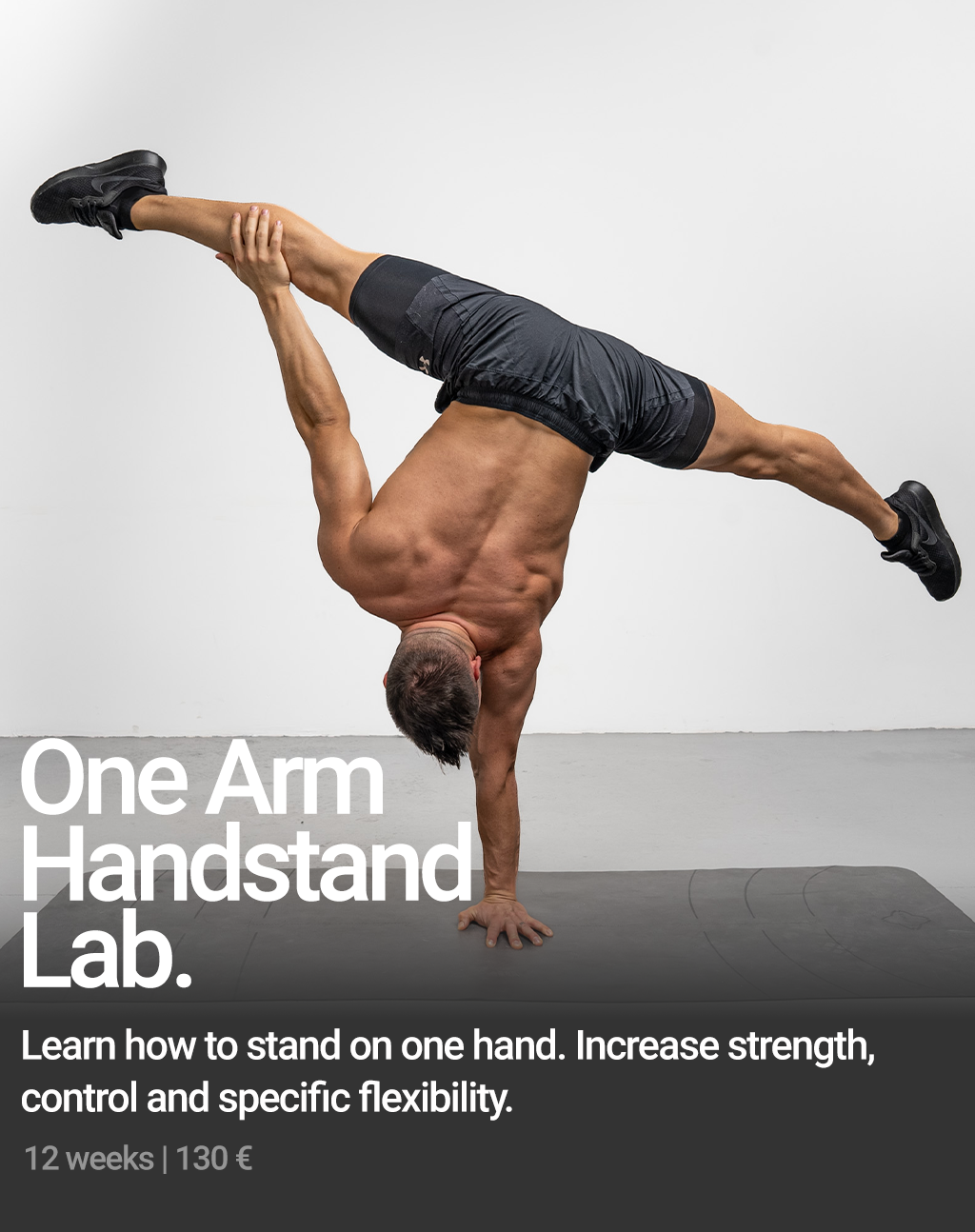







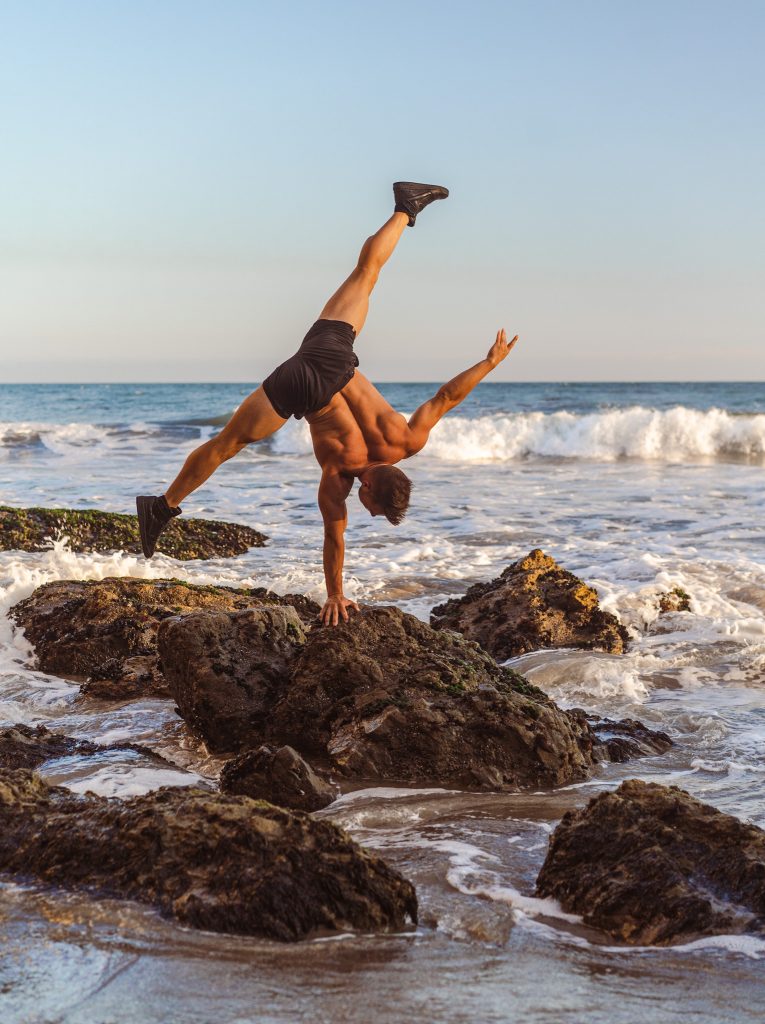
Epic post!! Thanks for sharing it